You’ve designed, built, and tested a piece of software, and you’re ready to ship it. That’s great – but you also need to tell your customers about that feature or change. Why? Better communication around product changes can increase trust with customers and more engagement with your product. Don’t let your hard work go unnoticed. Release days are exciting, so celebrate them more effectively by using one of these release notes tools!

If you don’t already publicize your product changes through release notes, there’s no need to worry. Many product teams drop the ball here, but it’s never too late to start. This post will look at some popular release notes tools that can help keep your customers in the loop when things change. They can also serve as a reference place to view product release details.
Essential features to consider in a release notes software
There’s a tool for everything these days. Sure, you can use a homegrown solution to announce a release or just use the blog on your website. But keep in mind your fanfare might get lost in the mix of other content. That’s why increasingly more businesses use tools dedicated to managing and publishing these updates. So here are some features to consider when choosing the right product for you.
Ease of use
You’ve already put in the hard work to design and build your software features. Publishing release notes should be easy, so there’s no reason why you should have to deploy code or write HTML and CSS to publish. Use a modern content management system to organize your notifications, so it’s easier and more accessible for people in your organization.
Visually pleasing
Don’t just tell your users what’s changed; show them. Make sure you can easily include screenshots, GIFs, and videos in your release notes when required to showcase the work you’re announcing. Also, the webpage where your release notes are published should look as attractive as your product. In fact, your should treat your release notes as part of your product. Give them the first-class status they deserve and make sure they look great.
Public and private access controls
Depending on your audience, you may need to keep your release notes private or public. Or, you may want a dedicated set of internal release notes for your team to communicate details that might not be necessary or appropriate for customers.
Notifications & subscriptions
Your power users might be chomping at the bit to know what’s changing in your product. Give them the ability to receive automatic notifications when you publish release notes. This way, they are always in the loop and don’t have to go hunting for the information they want, and they’ll never miss an important update again.
Integrations with your existing tools
Software teams use various tools to communicate, produce work, and collaborate. You might want your release notes tool to sync to some of those tools automatically. For example, when you publish a release note, you may want to send a notification to Slack or Twitter. Or you might want to receive the information from a tool like Jira.
The ability to embed release notes into your application
It’s essential to surface your release notes where your users already look, such as within your application. Most release notes tools can embed notes into other web pages or applications through a simple copy and paste code snippet.
Release Notes Tools List
Now, let’s look at some of the release notes tools available.
1. Headway
Headway is a clean and simple tool for publishing and sharing release notes. Simplicity is at the core of Headway, as seen in the minimal amount of features and lean design. For example, Headway lets users define multiple categories, configure colors for those categories, and apply any number of sections to a release note as needed.
The embeddable widget lets you surface release notes within your application or web page to ensure your users see them once published.
Headway doesn’t currently offer a notifications feature, but according to their public roadmap, this is coming in the future.
Key features:
- Custom category colors
- Embeddable widget
- Loom video embed support
Website: headwayapp.co
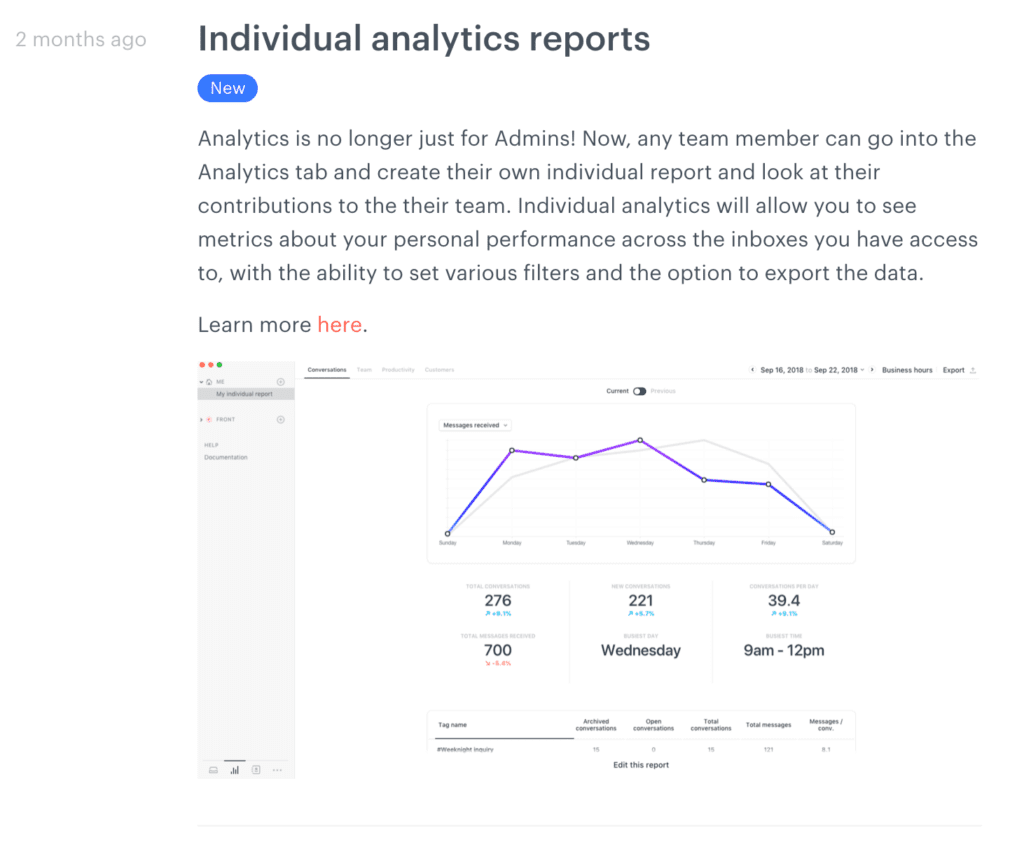
2. LaunchNotes
LaunchNotes is a release notes tool built by ex-Atlassian employees for product change communicators. What’s unique about LaunchNotes is that it supports both sides of release communication: internal communication to enable teams with the information they need to support a release, and external communication to inform and educate customers.
Built on a powerful categorization system, LaunchNotes allows each team to create custom categories that map to their specific team or organization structure. In addition, subscribers can select to receive only relevant updates. LaunchNotes also have a powerful GraphQL API that allows software teams to extend the reach of their updates into any other web property or applicable system.
LaunchNotes has recently increased in popularity with teams from popular software companies who use it as an elegant and easy way to communicate product changes.
Key features:
- Slack integration
- Ability to restrict access to specific stakeholders
- Categorical subscription options
- Ability to collect feedback and customer sentiment on a release note
Website: launchnotes.com
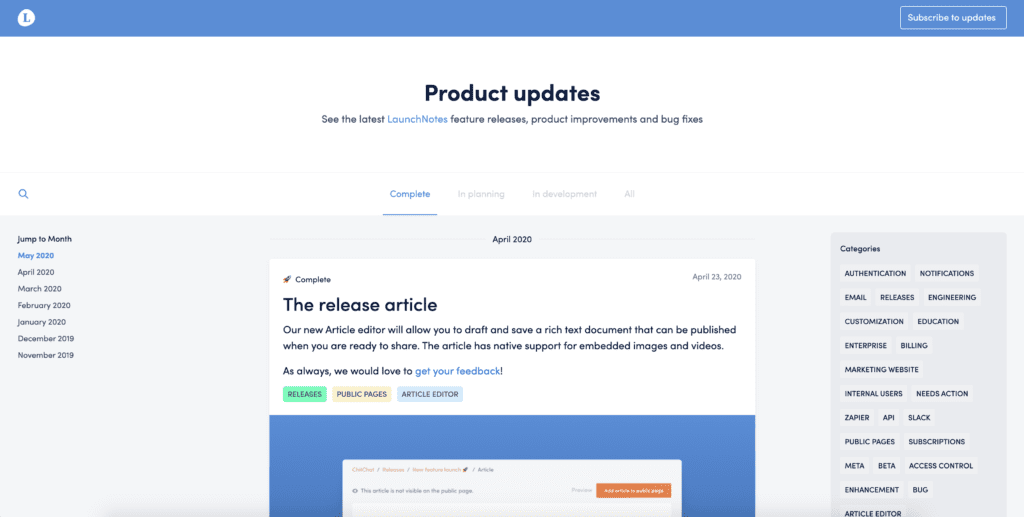
3. Noticeable
Noticeable is a slick-looking release notes tool that allows your customers to add comments and emoji sentiments to your releases. This makes release notes more interactive and provides more data and insights back to product teams. Noticeable also offers view metrics that update in real-time as your users view the release notes.
You can organize your notes by categories, and your users can filter by those categories in the navigation on the right side of their user interface.
While most companies use Noticeable for communicating product updates, some companies use their product to create and maintain a timeline of important company events and moments.
Key features:
- Embeddable widget
- Integration with GitHub
- Slack integration for internal updates
- Twitter integration for external updates
Website: noticeable.io
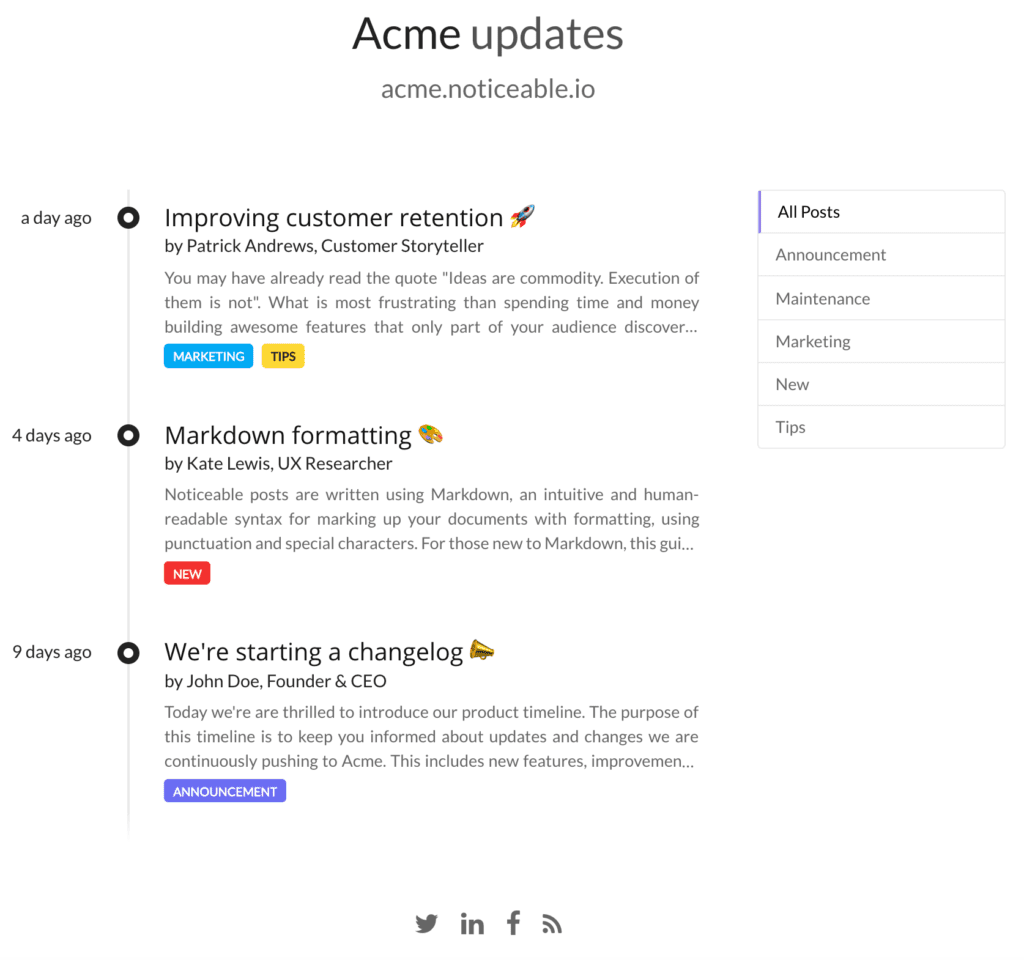
4. Releasenotes.io
Releasenotes helps product teams showcase their releases by including different buckets for each release. For example, a single release can segment into different categories like “bug fixes,” “updates,” and “features,” which historically has been a pretty standard way of formatting release notes.
With Releasenotes.io, you can also credit teammates who worked on the release, so customers can see who was responsible for the work, which is a nice personal touch. Like other tools on this list, Releasenotes.io enables you to embed a banner on your website or application to showcase the product changes. The banner also includes an “unread” badge to let users know which release notes are new or have already seen.
Releasenotes.io has an optional feature where you can collect feedback from customers on your releases, so you can tell if you’ve hit the mark or not.
Key features:
- Flexible release categories
- Email notifications
- Private release notes
Website: releasenotes.io
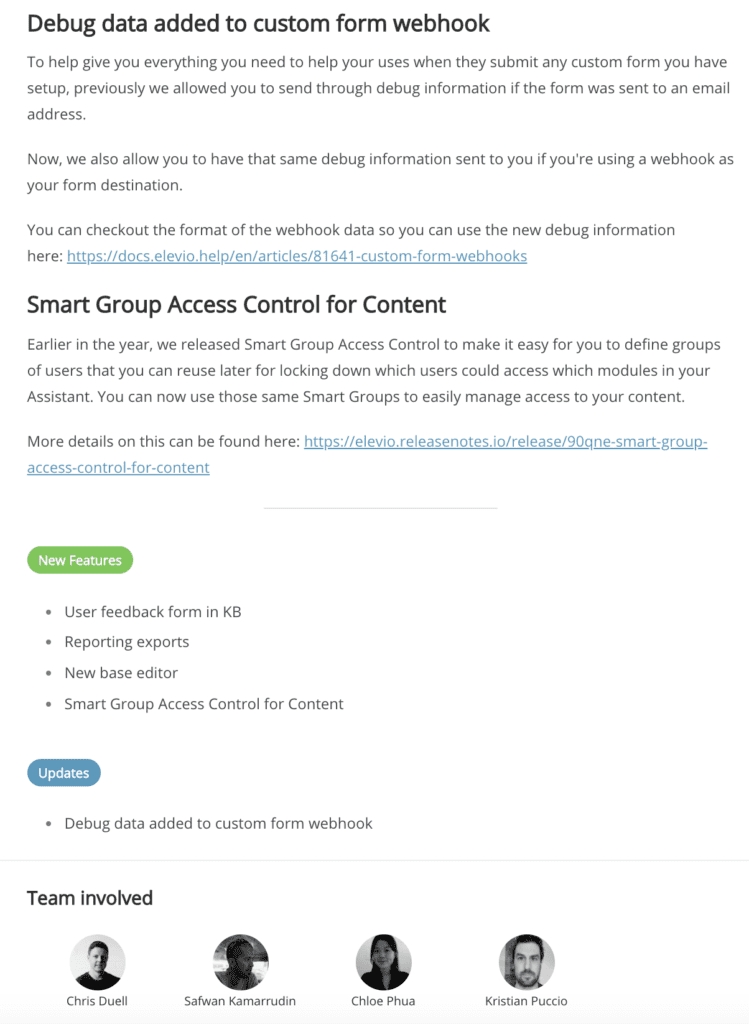
5. Announcekit
Announcekit is another release notes tool that aims to be a simple and lightweight solution for publishing release notes. The Announcekit UI feels similar to Headway in that they are both straightforward to use and un-intimidating at first glance. Again, similar to Noticeable, you can sort releases by category in Announcekit.
Announcekit supports notifications via Email and Slack so your users can stay up to date all of the time. They also have multi-language support, which is great for global products.
As with other tools in this list, you can collect feedback and measure customer sentiment on each release note you publish. They also have a webhook integration, allowing users to connect Annoucekit to a wide range of other tools.
Key features:
- Multi-language support
- Email and Slack notifications
- Webhooks
- Analytics dashboard
Website: announcekit.app
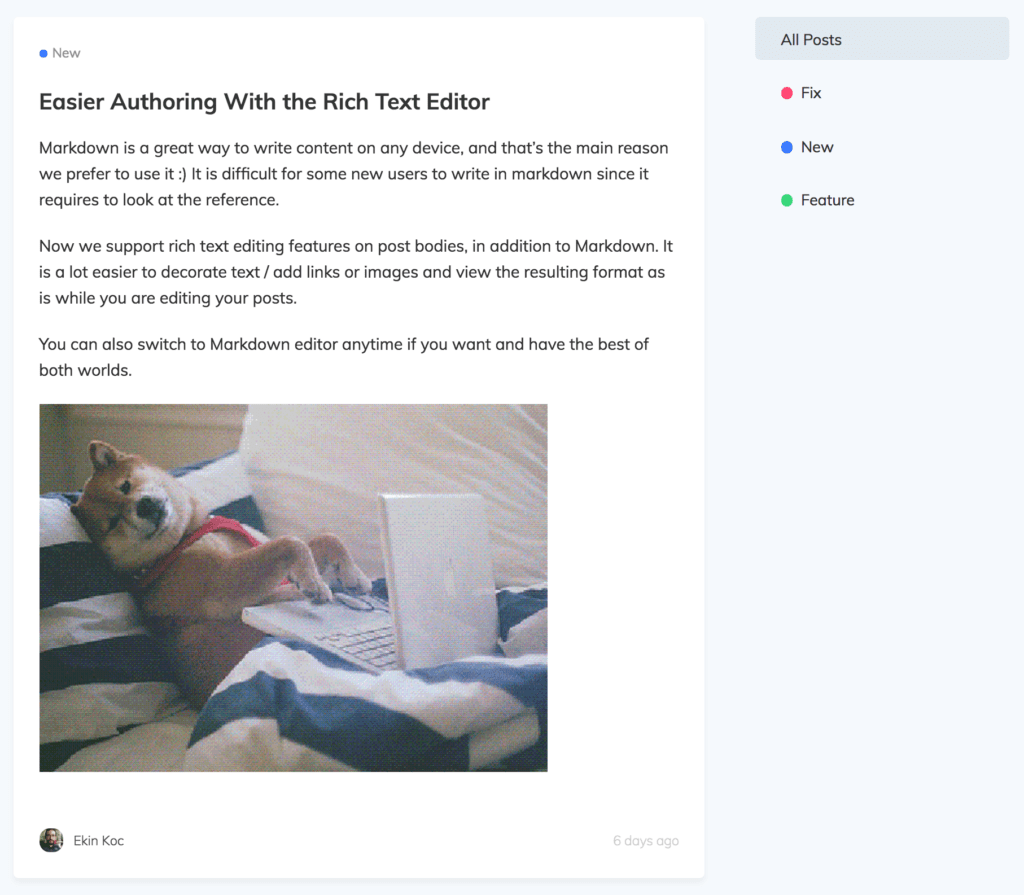
6. Beamer
Beamer positions itself as more of a user engagement tool, which makes sense because release notes can increase user engagement if done right.
Like Noticeable and other tools mentioned here, Beamer has a feature where users can “vote” using an emoji sentiment. This gives product teams an instant feedback loop into their users’ feelings about a particular product release.
Beamer has a built-in push notification feature that enables you to create a call to action and control where users go after clicking the button. The idea here is that a push notification is more likely to get attention than an email, bringing users back into your website or application at a higher rate.
Key features:
- Ability to schedule posts
- Customizable CSS
- Analytics to measure flicks, views, location, and more
- Embedded widget
- Multi-language support
Website: getbeamer.com
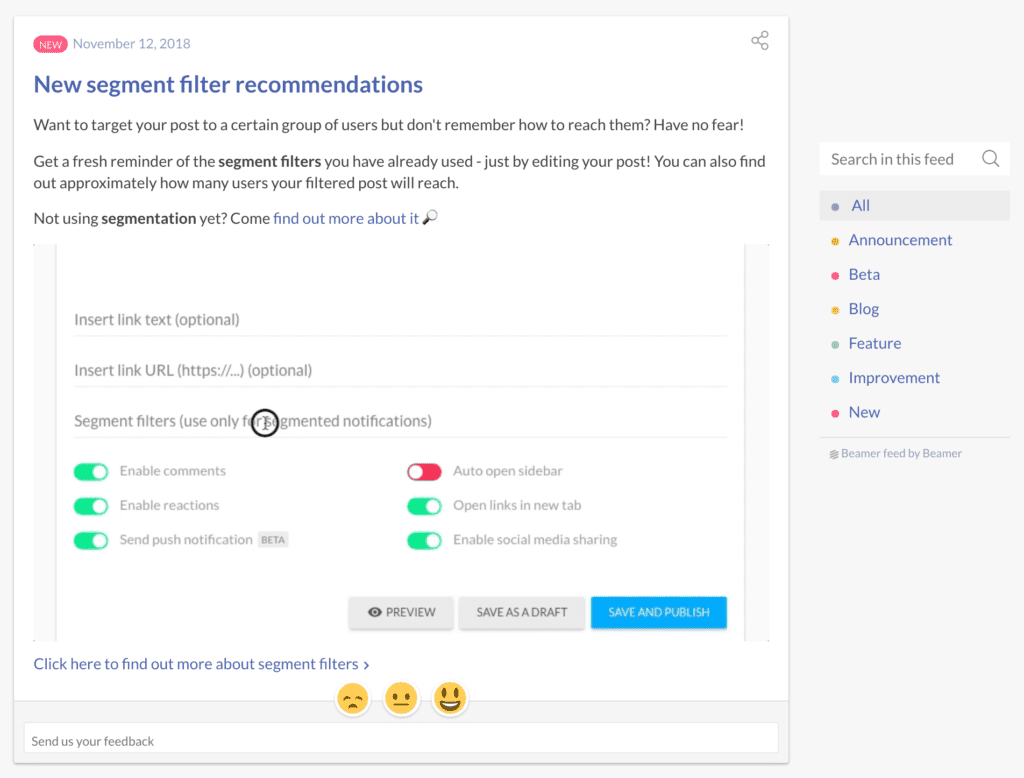
7. Onset.io
Onset appears to be focusing on brief release notes entries where a single release has multiple categories. This is similar to the Releasenotes.io model.
You can schedule releases in Onset and integrate with hundreds of other tools, including GitHub, Bitbucket, Trello, Mailchimp, and more through Zapier. Their extensive integration library enables you to use Onset with your existing workflows.
Onset supports semantic versioning, making it stand out from other tools on this list. This feature can be really appealing for systems with many dependencies or versions because Onset helps you apply and manage version numbers to your software releases.
Key features:
- Semantic versioning
- Integrations with hundreds of other tools
- Custom branding
- Rest API
- User reactions and sentiment tracking
Website: onset.io
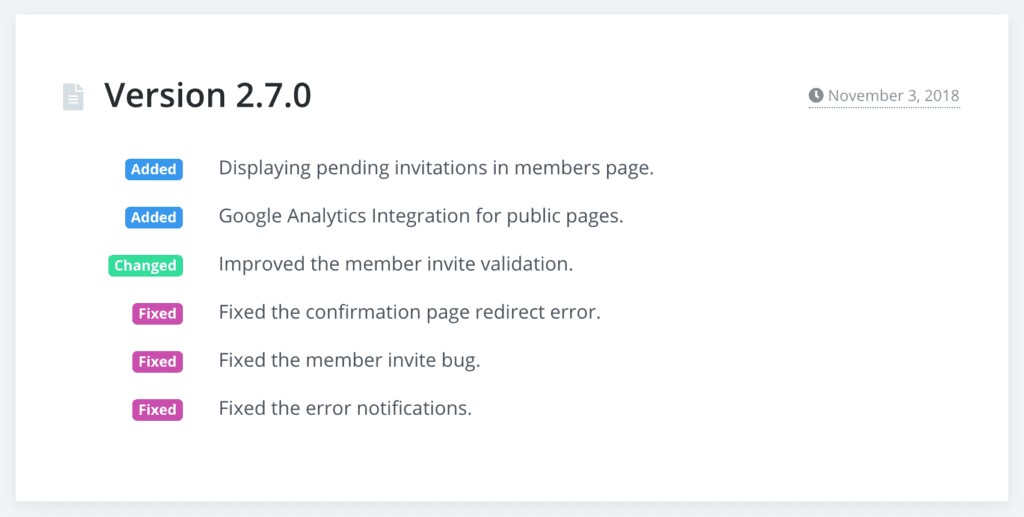
Conclusion
Release notes are often the forgotten piece of software development. Don’t let your team fall into the trap. Start communicating your releases in a consistent place, where your customers can easily access to see what’s changed. Depending on your release cadence and the size of your releases, you may find some of the tools above are a better fit than others.

